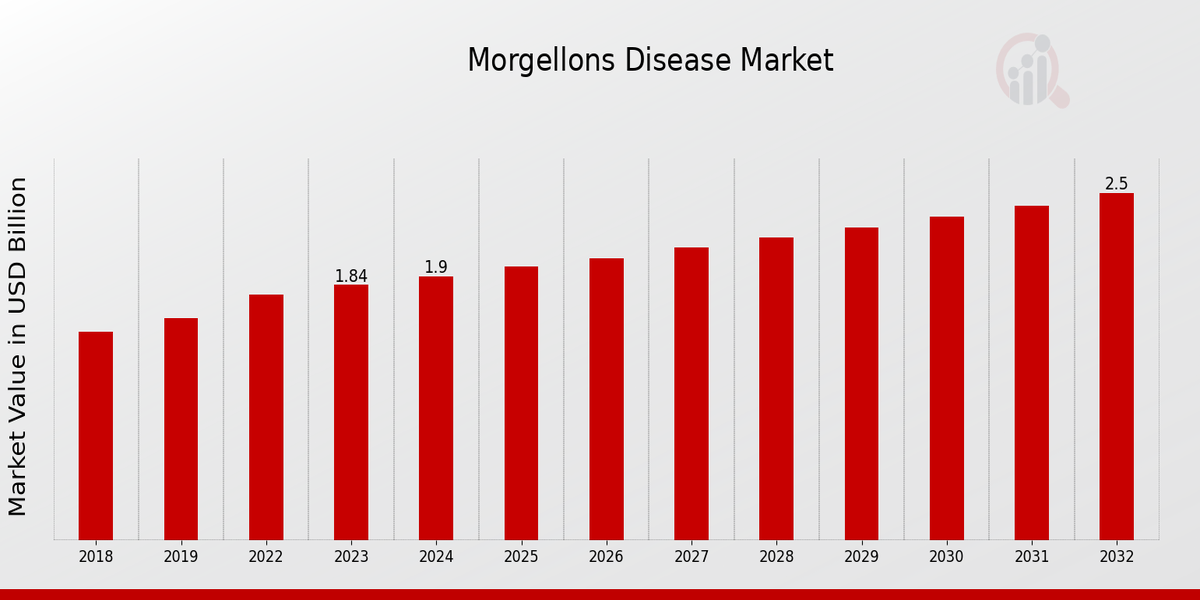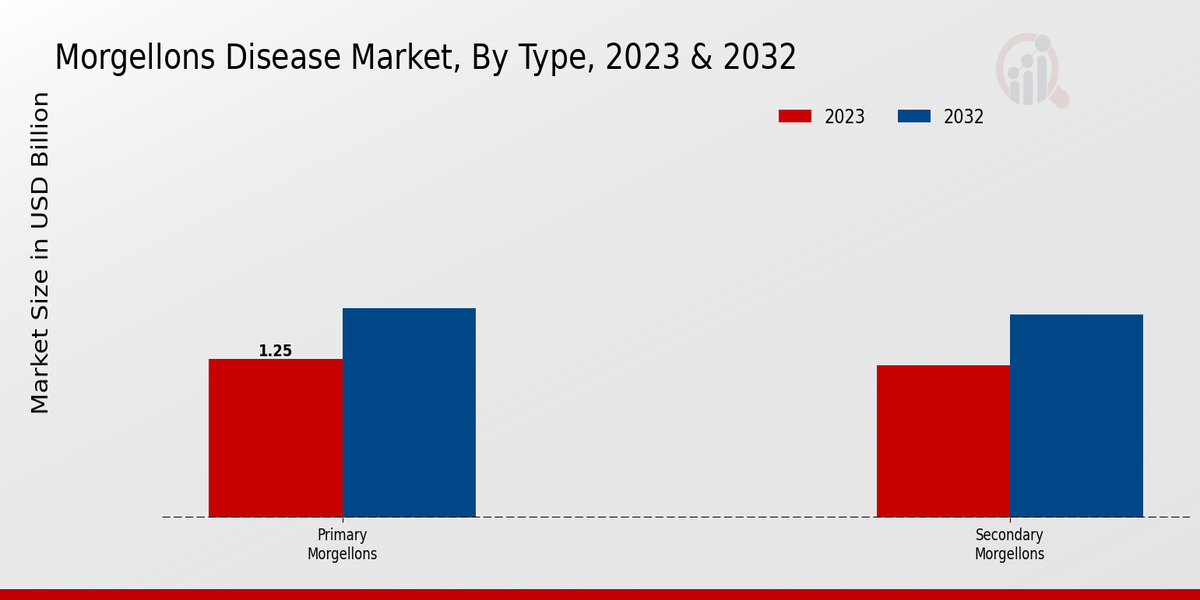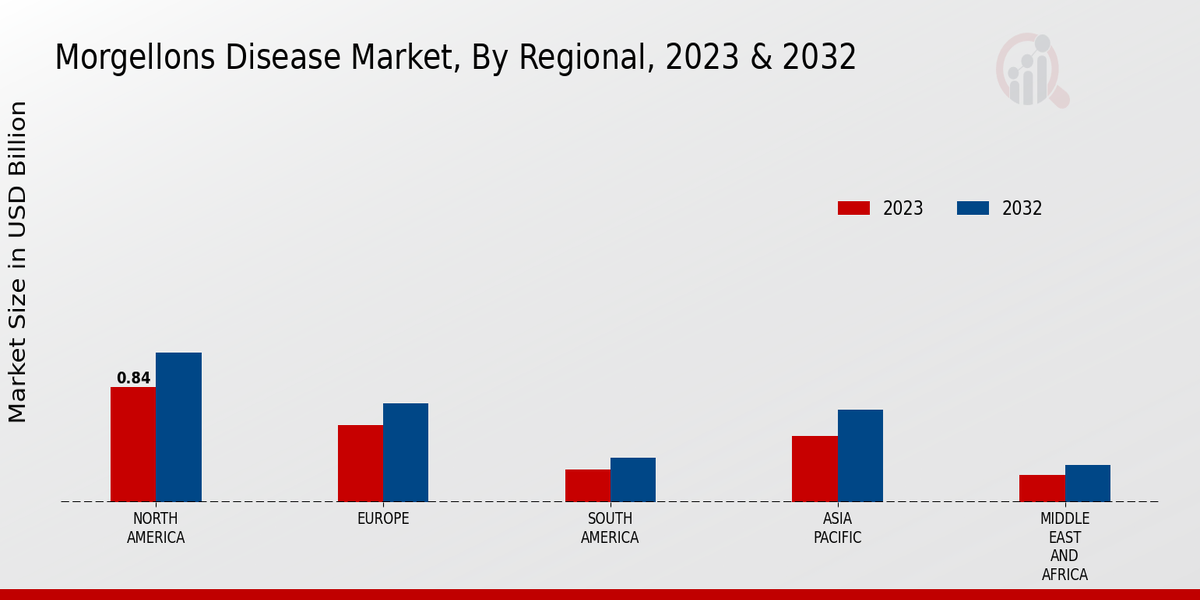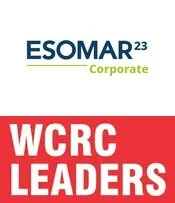Global Morgellons Disease Market Overview
As per MRFR analysis, the Morgellons Disease Market Size was estimated at 1.77 (USD Billion) in 2022. The Morgellons Disease Market Industry is expected to grow from 1.84(USD Billion) in 2023 to 2.5 (USD Billion) by 2032. The Morgellons Disease Market CAGR (growth rate) is expected to be around 3.49% during the forecast period (2024 - 2032).
Key Morgellons Disease Market Trends Highlighted
Key market drivers for the Morgellons Disease Market include the increasing awareness of the condition, the growing prevalence of chronic diseases and the rising demand for alternative therapies. Opportunities exist in novel development for diagnostic and therapeutic procedures, investigating environmental factors of the disease and focusing on the stigma surrounding Morgellon disease. Recent trends include the occurrence of support groups on the internet, the use of social networks for promotion, and a greater willingness to use integrative techniques to control the illness.

Source: Primary Research, Secondary Research, MRFR Database and Analyst Review
Morgellon Disease Market Drivers
Increased Awareness and Recognition of Morgellon Disease
In recent years, Morgellon disease has gained increased recognition and awareness among both medical professionals and the general public. This has been driven by several factors, including the establishment of dedicated research centers, the work of advocacy groups, and the sharing of patient experiences online. As a result, more people are becoming aware of the condition and seeking diagnosis and treatment. This increased awareness is expected to continue in the coming years, further fueling the growth of the Morgellons disease market.
Advancements in Diagnostic Techniques
The development of more accurate and reliable diagnostic techniques is another key driver of the Morgellons disease market. In the past, Morgellon disease was often difficult to diagnose due to the lack of specific biomarkers or diagnostic tests. However, recent advances in technology have led to the development of new diagnostic tools that can help to identify the condition more accurately. These tools include advanced imaging techniques, such as MRI and CT scans, as well as genetic testing.
Growing Demand for Effective Treatments
Morgellons Disease Market Introduction Morgellons disease is a chronic and debilitating disease that currently has no known cure. However, there are several treatment options available to manage the symptoms of the disease. The treatments include but are not limited to, medications such as antibiotics and anti-inflammatories, as well as lifestyle changes such as dietary changes and stress management. The number of people being diagnosed with Morgellon disease is on the rise, and so is the need for effective treatment. The increasing need for treatment is a factor that is expected to drive the growth of the Morgellons disease market over the forecast period.
Morgellons Disease Market Segment Insights
Morgellons Disease Market Type Insights
Morgellon disease is a controversial and poorly understood condition characterized by the presence of unexplained skin lesions and fibers. It is often classified into two types: primary Morgellons and secondary Morgellons. Primary Morgellons are characterized by the presence of unexplained skin lesions and fibers that are thought to be caused by an unknown infectious agent. These lesions can be painful, itchy, and disfiguring. They can also lead to a variety of other symptoms, including fatigue, headaches, and joint pain. Secondary Morgellons are characterized by the presence of unexplained skin lesions and fibers that are thought to be caused by a known medical condition, such as a skin infection or a psychiatric disorder.The market is segmented by type, diagnosis, treatment, and region. By type, the market is segmented into primary Morgellons and secondary Morgellons. The primary Morgellons segment is expected to hold a larger market share during the forecast period due to the increasing prevalence of the condition. The Morgellons Disease Market is a rapidly growing market with a number of factors driving growth. These factors include the increasing prevalence of the condition, the rising awareness of the condition, and the development of new treatments.

Source: Primary Research, Secondary Research, MRFR Database and Analyst Review
Morgellons Disease Market Cause Insights
Cause Segment Overview and Insights The cause of Morgellon disease remains unknown, but several theories have been proposed. One theory suggests that it is caused by a Borrelia infection, which is transmitted by ticks. Another theory suggests that environmental toxins, such as heavy metals or pesticides, cause it. A third theory suggests that it is caused by neurological disorders, such as multiple sclerosis or Parkinson's disease. Borrelia Infection Borrelia burgdorferi is a bacterium that causes Lyme disease. Lyme disease is a common tick-borne illness that affects the skin, joints, and nervous system.Some researchers believe that Borrelia burgdorferi may also cause Morgellon disease. This theory is supported by the fact that many people with Morgellon disease have also tested positive for Lyme disease. Environmental Toxins Environmental toxins are chemicals that can be harmful to human health. Some researchers believe that exposure to environmental toxins, such as heavy metals or pesticides, may cause Morgellon disease. This theory is supported by the fact that many people with Morgellon disease live in areas that are contaminated with environmental toxins.Neurological Disorders Neurological disorders are conditions that affect the brain and nervous system. Some researchers believe that neurological disorders, such as multiple sclerosis or Parkinson's disease, may cause Morgellon disease. The growth of the market is attributed to the increasing prevalence of Morgellon disease and the rising awareness of the condition.
Morgellons Disease Market Diagnostic Method Insights
The Diagnostic Method segment of the Morgellons Disease Market is anticipated to witness substantial growth in the coming years. Microscopy, skin biopsy, and blood tests are the primary diagnostic methods employed in the detection of Morgellon disease. Microscopy involves examining skin samples under a microscope to identify the presence of characteristic fibers or filaments associated with the condition. Skin biopsy, on the other hand, entails the removal of a small piece of skin for further analysis under a microscope. Blood tests are also utilized to detect the presence of antibodies or other markers indicative of Morgellon disease.The Morgellons Disease Market is expected to reach a valuation of USD 1.84 billion by 2023, with a projected CAGR of 3.49% during the forecast period from 2024 to 2032.
Morgellons Disease Market Treatment Insights
Antibiotics, antihistamines, and antipsychotics are the most commonly used treatments for Morgellon disease. Antibiotics are used to treat bacterial infections, which are often a secondary complication of Morgellon disease. Antihistamines are used to relieve itching and other allergic reactions. The increasing prevalence of Morgellon disease is a major factor driving the growth of the market. The market is also expected to benefit from the growing awareness of Morgellon disease and the development of new and more effective treatments. The treatment segment is expected to account for the largest share of the Morgellons Disease Market in 2023.The growth of this segment is attributed to the increasing number of patients seeking treatment for Morgellon disease and the availability of a wide range of treatment options.
Morgellons Disease Market Regional Insights
The Morgellons Disease Market is segmented into North America, Europe, APAC, South America, and MEA. North America is expected to hold the largest share of the market in 2023, with a valuation of around USD 0.84 billion. This is due to the increasing prevalence of Morgellon disease in the region, as well as the presence of a large number of healthcare providers and research institutions. Europe is expected to be the second-largest market, with a valuation of around USD 0.56 billion in 2023. The market in APAC is expected to grow at the highest CAGR of 4.5% during the forecast period due to the increasing awareness of Morgellon disease and the growing healthcare expenditure in the region.South America and MEA are expected to account for a smaller share of the market, with valuations of around USD 0.24 billion and USD 0.2 billion, respectively, in 2023.

Source: Primary Research, Secondary Research, MRFR Database and Analyst Review
Morgellons Disease Market Key Players And Competitive Insights
Major players in the Morgellons Disease Market are continuously working on the development of new products and technologies to meet the growing demands of the market. These players are also involved in strategic collaborations and partnerships to expand their global reach and strengthen their market position. The Morgellons Disease Market industry is expected to witness significant growth in the coming years, owing to the increasing prevalence of Morgellons disease and rising awareness among healthcare professionals.One of the leading Morgellons Disease Market players is Herbalife Nutrition. The company is a global leader in the nutrition industry and offers a wide range of products, including dietary supplements, vitamins and minerals, and weight management products. Herbalife Nutrition has been actively involved in the research and development of Morgellons disease treatments and has a strong presence in the market.A key competitor in the Morgellons Disease Market is Tahoma Clinic. The clinic is a leading provider of integrative medicine and offers a range of treatments for Morgellon disease, including ozone therapy, chelation therapy, and hyperbaric oxygen therapy. Tahoma Clinic has a team of experienced healthcare professionals who are dedicated to providing personalized care for patients with Morgellon disease.
Key Companies in the Morgellons Disease Market Include
- Baylor Scott White Health
- Quest Diagnostics
- Intermountain Healthcare
- Johns Hopkins Medicine
- MD Labs
- Stanford Health Care
- UCLA Health
- Kaiser Permanente
- Mayo Clinic
- Cleveland Clinic
- Henry Ford Health System
- Barnes-Jewish Hospital
- University of Utah Health
- Spectral Diagnostics
- Cedars-Sinai Medical Center
Morgellons Disease Market Industry DevelopmentsThe Morgellons Disease market is gaining increasing attention due to growing awareness and research efforts. In 2023, the market was valued at approximately USD 1.84 billion and is projected to reach USD 2.5 billion by 2032, exhibiting a CAGR of 3.49% during the forecast period (2024-2032).Key factors driving market growth include the rising prevalence of Morgellon disease, increasing awareness among healthcare professionals, and ongoing research and development activities to develop effective treatments. Collaborations between researchers and industry players are fostering innovation and advancing the understanding of the disease. Government initiatives and funding for research are also contributing to the market's expansion. However, challenges such as lack of definitive diagnostic criteria and limited treatment options may hinder market growth to some extent.
-
Morgellons Disease Market Segmentation Insights
-
Morgellons Disease Market Type Outlook
- Primary Morgellons
- Secondary Morgellons
-
Morgellons Disease Market Cause Outlook
- Borrelia Infection
- Environmental Toxins
- Neurological Disorders
-
Morgellons Disease Market Diagnostic Method Outlook
- Microscopy
- Skin Biopsy
- Blood Test
-
Morgellons Disease Market Treatment Outlook
- Antibiotics
- Antihistamines
- Antipsychotics
-
Morgellons Disease Market Regional Outlook
-
North America
-
Europe
-
South America
-
Asia-Pacific
-
Middle East and Africa
| Report Attribute/Metric |
Details |
| Market Size 2022 |
1.77(USD Billion) |
| Market Size 2023 |
1.84(USD Billion) |
| Market Size 2032 |
2.5(USD Billion) |
| Compound Annual Growth Rate (CAGR) |
3.49% (2024 - 2032) |
| Report Coverage |
Revenue Forecast, Competitive Landscape, Growth Factors, and Trends |
| Base Year |
2023 |
| Market Forecast Period |
2024 - 2032 |
| Historical Data |
2019 - 2022 |
| Market Forecast Units |
USD Billion |
| Key Companies Profiled |
Baylor Scott White Health, Quest Diagnostics, Intermountain Healthcare, Johns Hopkins Medicine, MD Labs, Stanford Health Care, UCLA Health, Kaiser Permanente, Mayo Clinic, Cleveland Clinic, Henry Ford Health System, Barnes Jewish Hospital, University of Utah Health, Spectral Diagnostics, Cedars-Sinai Medical Center |
| Segments Covered |
Type, Cause, Diagnostic Method, Treatment, Regional |
| Key Market Opportunities |
Increased awareness of therapeutic advancements and initiatives diagnostic advancements government support |
| Key Market Dynamics |
Increasing Lyme Disease Prevalence Growing Awareness Lack of Consensus on Diagnosis Limited Treatment Options Rising Healthcare Expenditure |
| Countries Covered |
North America, Europe, APAC, South America, MEA |
Frequently Asked Questions (FAQ) :
The Morgellons Disease Market is projected to register a CAGR of 3.49% from 2024 to 2032.
The Morgellons Disease Market is expected to reach USD 2.5 billion by 2032.
North America is expected to hold the largest market share in the Morgellons Disease Market.
The diagnosis segment is expected to hold the largest market share in the Morgellons Disease Market.
Key competitors in the Morgellons Disease Market include Bio-Reference Laboratories, Inc., LabCorp, Quest Diagnostics Incorporated, and Mayo Clinic.
Major factors driving the growth of the Morgellons Disease Market include increasing awareness of the disease, rising prevalence of chronic diseases, and technological advancements in diagnostics.
Challenges faced by the Morgellons Disease Market include lack of consensus on diagnostic criteria, limited treatment options, and high cost of treatment.
Opportunities for growth in the Morgellons Disease Market include increasing research and development, development of new diagnostic tools, and expansion into emerging markets.
Key trends in the Morgellons Disease Market include the increasing use of telemedicine, the development of personalized treatment plans, and the growing focus on patient-centered care.















